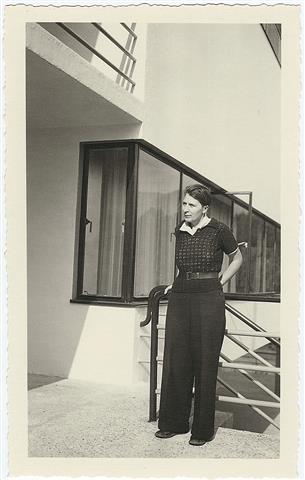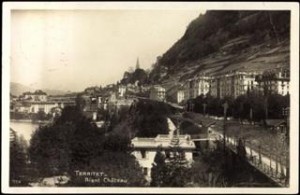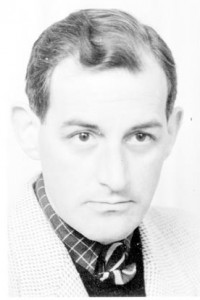The Bryher Chronology: Biography, Dates, and Further Reading
By Celena E. Kusch, 17 Feb. 2014

Bryher (Annie Winifred Ellerman) is best known as H.D.’s same-sex partner in an open relationship lasting over 40 years and including the adoption of H.D.’s daughter, Perdita. A prolific writer of memoirs, historical novels, poetry, and criticism, Bryher must also be seen as one of the cornerstones of modernism, serving as a personal patron of dozens of modernists, promoting and supporting experimental writing and film through her own press and magazine enterprises, including POOL Productions, Brendin Publishing Co., Close Up, Life and Letters Today, and Contact Editions (founded by Robert McAlmon and William Carlos Williams with funding from Bryher’s marriage to McAlmon), and sustaining other presses and institutions of modernism, such as Sylvia Beach’s Shakespeare & Co. and Harriet Shaw Weaver’s Egoist Press. Bryher was an avid supporter and vocal advocate of international film, psychoanalysis, political freedom, anti-fascism, progress in myriad forms, and just plain modernity.
Daughter of multi-millionaire Sir John Ellerman who did not marry her mother until 14 years after her birth, Bryher was born into tremendous wealth, but with none of the public ostentation or even active participation in elite social circles. The family traveled extensively as part of Ellerman’s shipping business and other enterprises, and Bryher developed a sense of identity that was truly modern in its defiance of the importance of marriage and conventional gender roles; its transgression of borders of nations, cultures, religions, and languages; and its utter embrace of change. Her own home in Switzerland, the Bauhaus home, Kenwin, was a testament to modern architecture and is now listed on the Swiss register of historic places.
In an attempt to understand her non-normative gender identity (today we would use the term transgender), Bryher turned to the fledgling field of psychoanalysis, discussing theories of inversion rather than lesbianism with Havelock Ellis and Hanns Sachs. Her interest in the field led her to pursue a license as a lay analyst, though the looming war and changes in the field itself led her to abandon this line of work.
Throughout her life, Bryher used her considerable fortune and exceptional business acumen to propel the fields of experimental poetry and fiction, film, and psychoanalysis. Her direct beneficiaries included Dorothy Richardson, Sylvia Beach, Edith Sitwell, James Joyce, Verlag, the publisher of psychoanalysis (through Sigmund Freud), Blanche Lewin, Robert McAlmon, Hanns Sachs, Kenneth Macpherson, Marianne Moore, H.D., and many of their relatives and friends. Bryher’s 1933 essay published in one of the final issues of Close Up,“What Shall You Do in the War?” served as a call to action to preserve art, science, and the world against fascism. Following her own advice, Bryher directly assisted 105 refugees, many psychoanalysts, in their attempt to escape from Nazi rule.
Timeline
1886 John Ellerman founds his own accounting firm, John Ellerman & Co. at 10 Moorgate, London
1890 John Ellerman founds Brewery and Commercial Investment Trust
1892 John Ellerman purchases Leyland & Co. shipping lines
1894 Bryher is born Annie Winifred Glover (2 Sept.) at Norfolk Villa, Harold Road, Margate, to Hannah Glover and John Ellerman (unmarried). Note: The Oxford Dictionary of National Biography lists Bryher’s birthplace as Norfolk Villa, but the Norfolk Villa is on Hatfield Road. According to Anthony Lee of the the Margate Local History Web site, Norfolk House was on Harold Road at the NW corner of Albion and Harold
1895 Yale University’s Beinecke Digital Collection includes a photo of Bryher with a dog in a carriage pulled by a goat
1900 Bryher travels to Paris with her family. Travel becomes an important part of her childhood, including extended visits to Algeria, Spain, Greece, Italy, Egypt. A childhood photo of Bryher is included in one of H.D.’s scrapbooks
1901 John Ellerman founds London, Liverpool, and Ocean Shipping Co.
1902 John Ellerman expands and founds Ellerman Lines and Ellerman’s Wilson Line
 1903 Bryher travels to Egypt with her family. Bryher learns Arabic. She will take Arabic lessons later in her youth as well
1903 Bryher travels to Egypt with her family. Bryher learns Arabic. She will take Arabic lessons later in her youth as well
1904 Ellerman expands into newspapers and publishing fields, becoming the largest shareholder in Financial Times. He later becomes a major shareholder in The Tatler, The Sphere, Illustrated London News, Daily Mail, The Times, and Associated Newspapers
1905 Sir John Ellerman named Baronet for his role in shipping during the Boer War (Dictionary of National Biography)
1909 Sir John Ellerman arranges to marry Hannah Glover under Scottish law, but Burke’s Peerage lists the date of marriage as 14 Oct 1908 (Dictionary of National Biography)
1909 Sir John Ellerman II born in December.
1910-1912 Bryher attends Queenwood School, Eastbourne. An image of Bryher from this period is available through the Beinecke Digital Collections. Another image, labeled “Self in bad temper” features Bryher in 1912
1914 Bryher publishes poetry collection, Region of Lutany (London: Chapman & Hall)
1917 Bryher begins publishing articles
1917 Bryher writes to Amy Lowell
1918 Bryher meets H.D. Note: Bryher still used the name Winifred Ellerman when she met H.D. on July 17, 1918 (Jane Augustine note).
1918 Bryher publishes “Some Essentials in Modern American Poetry” 31 Aug. 1918, Saturday Review1918 Bryher meets Havelock Ellis and discusses his theories of inversion
1918 Bryher publishes a translation of The Lament for Adonis by Bion of Phlossa (London: A. L. Humphreys). In Richard Aldington and H. D.: Their Lives in Letters 1918-1961 (Manchester and New York: Manchester UP), editor Caroline Zilboorg notes that Bryher wrote only five pages of translation, based on J. M. Edmunds’s earlier translations (150). Aldington’s letter to H.D. about the project states that Bryher needed to “learn Greek” and improve the translation (150). According to Zilboorg, Bryher’s introduction to the book echoed Aldington’s theory of translation from The First Poet’s Translation Series.
1918 Bryher publishes Amy Lowell: A Critical Appreciation (London: Eyre & Spottiswoode)
1919 Bryher moves out of 1 S. Audley Street, London, The Dictionary of National Biography 1931-1940 describes the home as a “great Victorian mansion at 1 South Audley Street.,his house overflowed with mosaics, tapestries, carvings, furniture, and a medley of objects, some of them works of art and others without value” (255-7). Bryher begins traveling to Greece with H.D. and Havelock Ellis. Bryher assumes responsibility for care of Perdita Aldington
1920 Bryher and H.D. visit the US, including New York and California. Contacts include Marianne Moore and Amy Lowell
1920 Bryher publishes “An Impression of America” in The Sphere
1920 Bryher publishes Development (New York: Macmillan) with preface by Amy Lowell. Note: The title page lists W. Bryher as the author’s name (Jane Augustine’s note).
1921 Bryher marries Robert McAlmon, and Ellerman funds Contact magazine and later Contact Publishing
1921 Bryher and H.D. publish Marianne Moore’s Poems with Harriet Shaw Weaver’s Egoist Press
1922 Sir John Ellerman begins selling off his shares in newspapers
1922 Bryher publishes her second poetry collection, Arrow Music (London: J. & E. Bumpus)
1923 Bryher publishes Two Selves (Paris, Contact Publishing Co.)
1923 Bryher visits Egypt with H.D. and Helen Wolle Doolittle
1924 Bryher gives her first gift of funds to Dorothy Richardson, a year after they exchange their first letters. These gifts continue at a rate of about £100 per year, until Bryher establishes a trust for Richardson in 1933 with an annual income of £120/year (George Thomson, Dorothy Richardson: A Calendar of Letters. ELT Press, 2007)
1925 Bryher publishes West (London: Jonathan Cape)
1925 Bryher publishes A Picture Geography for Little Children: Part One: Asia (London: Jonathan Cape), illustrated by M. D. Cole
1927 Bryher divorces Robert McAlmon and marries Kenneth Macpherson
1927 Bryher flies with Macpherson to meet Sigmund Freud
 1927 Bryher and Macpherson found POOL Productions, working on the film Wingbeat. She also founds the little magazine, Close Up: An International Magazine Devoted to Film Art, which runs from 1927-1933, with Macpherson and Bryher as editors. POOL is based in Riant Château, Territet, Switzerland
1927 Bryher and Macpherson found POOL Productions, working on the film Wingbeat. She also founds the little magazine, Close Up: An International Magazine Devoted to Film Art, which runs from 1927-1933, with Macpherson and Bryher as editors. POOL is based in Riant Château, Territet, Switzerland
1927 Bryher meets G. W. Pabst in Berlin
1927 Bryher publishes Civilians (Territet, Switzerland: POOL)
1928 Bryher meets Hanns Sachs at a party with G. W. Pabst (See Susan McCabe. “Bryher and Berlin: Modernism’s Geographical Emotions.” The Berlin Journal 21 [2011]: 10) and begins psychoanalysis with Hanns Sachs in Berlin and Switzerland, analysis continues through 1932, when Sachs moves to Boston
1928 Bryher and Kenneth Macpherson legally adopt Perdita who becomes Perdita Macpherson
1928 POOL Films produces Foothills, starring H.D.
1929 Bryher publishes Film Problems of Soviet Russia (Territet, Switzerland: Pool)
1929 POOL Films produces Monkey’s Moon

1929 Bryher, Kenneth Macpherson, and Robert Herring travel to Iceland. Bryher chronicles some film-related details of this trip in the article, “A Certificate of Approval” in Close Up (December 1929): 483-487.
1930 POOL Films produces Borderline, featuring Paul Robeson, Eslanda Robeson, H.D. (as Helga Doorn), Gavin Arthur, Charlotte Arthur, Blanche Lewin, and Bryher
1930 Bryher publishes The Lighthearted Student: I German with Trude Weiss (Switzerland: POOL Publications)
1930-1931 Bryher and Kenneth Macpherson build Villa Kenwin, a Bauhaus home in La Tour-de-Peliz, Switzerland (near Vevey). It was built by architect Hermann Henselmann based on designs by Alexandre Ferenczy. It is a Swiss heritage site of national significance. See Le Court du Jour and the Kenwin documentary by Véronique Goël
1931 Bryher funds analysis for H.D. and Macpherson with Mary Chadwick
1932 Bryher funds analysis for H.D. with Hanns Sachs
1933 Sir John Ellerman dies (16 July), leaving an estate worth £36 million, nearly three times the value of the previous record in the UK. Ellerman is often called the wealthiest man in England in his time. See the BBC article “The Secretive Billionaire”
1933 Bryher establishes a trust for H.D. with annual income of £250. Smaller trusts are established for Dorothy Richardson and Blanche Lewin (George Thomson, Dorothy Richardson: A Calendar of Letters. ELT Press, 2007)
1933 Bryher publishes “What Shall You Do in the War?” in one of the final issues of Close Up, she reports on concentration camps and the burning of Pabst’s films in Berlin
1933 Bryher begins Jewish refugee work, aiding over 100 analysts, intellectuals, artists, and their families over the course of the next six years until the outbreak of WWII. She leant her assistance to Walter Benjamin, sending funds to Sylvia Beach to assist him once he made it to France, but he committed suicide at the Spanish border before he could escape. (See Marina Camboni, “Bryher and Walter Benjamin: Between Barbarism and Modernity.” H.D.’s Web Summer 2009)
1933 Bryher establishes the Hanns Sachs Training Fund for refugee analysts arriving in the US. She also contributes to International Psychoanalytischer Verlag to aid in publishing psychoanalytic research
1933 Bryher arranges for H.D. to begin psychoanalysis with Sigmund Freud at 19 Berggasse in Vienna, also begins a friendship with Anna Freud
1933 Elsie Volkart becomes Bryher’s housekeeper at Kenwin.
1934 Elsie Volkart travels to Iceland.
1935 Bryher founds Brendin Publishing Company and purchases Life and Letters, renaming it Life and Letters Today: An International Magazine of Living Letters, with Robert Herring and Petrie Townshend editors (Townshend resigned in 1937)
1935-36 Bryher publishes Manchester in serial form in Life and Letters Today
1936 Bryher and Macpherson attend a party for Dorothy West’s magazine, Challenge
1937 Bryher exchanges a copy of her Paris 1900 with Walter Benjamin for his Berlin Childhood around 1900
1938 Bryher publishes Pairs 1900 (Paris: La Maison des amis des livres), Sylvia Beach and Adrienne Monnier, translators
1938 Bryher is denied a lay analysis license by the Boston psychoanalytic society. She had been working with Hanns Sachs to obtain a license since the early 1930s
1939 Bryher funds Paula Heimann for a British medical degree at Edinburgh
1939 Bryher buys London Mercury and Bookman and merges them with Life and Letters Today (May issue)
1939 Bryher begins flying lessons
1939 Lady Ellerman dies in Cornwall
1940 Bryher escapes from Switzerland through France and Spain, arrives in London after about three months
1946 Bryher returns to Kenwin and moves H.D. to Kunach Clinic nearby to recover from a breakdown
1947 Bryher divorces Kenneth Macpherson
1947 Bryher travels to West Indies
1948 Bryher publishes Beowulf: roman d’une maison de thé dans Londres bombarde (Paris: Mercure de France)
1950 Life and Letters Today ceases publication
1953 Bryher meets Erich Heydt who is treating H.D.
1953 Bryher publishes The Player’s Boy (New York: Pantheon Books)
1954 Bryher publishes The Fourteenth of October (London: Collins)
1954 Bryher publishes Roman Wall (New York: Pantheon Books), also (London: Collins, 1955)
1956 Bryher publishes Beowulf: A Novel (New York: Pantheon Books)
1958 Bryher publishes Gate to the Sea (New York: Pantheon Books) also (London: Collins, 1959)
1960 Bryher publishes Ruan (New York: Pantheon Books)
1961 Bryher travels to Greenland
1962 Bryher publishes The Heart to Artemis: A Writer’s Memoirs (New York: Harcourt, Brace, and World)
1963 Bryher publishes The Coin of Carthage (New York: Harcourt, Brace and World)
1965 Bryher publishes Visa for Avalon (New York: Harcourt, Brace and World)
1966 Bryher publishes This January Tale (New York: Harcourt, Brace and World)
1969 Bryher publishes The Colors of Vaud (New York: Harcourt, Brace and World)
1972 Bryher publishes The Days of Mars: A Memoir, 1940-1946 (London: Calder and Boyars)
1983 Bryher dies at Kenwin (28 Jan.)
For Further Reading
Augustine, Jane. “Bryher (pseudonym of Annie Winifred Ellerman).” An Encyclopedia of British Women Writers. Eds. Paul Schlueter and June Schlueter. New York and London: Garland Publishing, 1988. 70-72.
Bryher Papers. General Collection, Beinecke Rare Book and Manuscript Library.
Camboni, Marina. “Networking Women: Subjects, Places, Links—Europe-America, 1890-1939.” HOW2 2.1 (2003).
Collecott, Diana. “Bryher.” The Sexual Imagination from Acker to Zola. Ed. Harriett Gilbert. London: Jonathan Cape, 1993.
Friedman, Susan Stanford, ed. Analyzing Freud: Letters of H.D., Bryher, and Their Circle. New York: New Directions, 2002. See first chapter at the New York Times.
Magee, Maggie, and Diana C. Miller. Lesbian Lives: Psychoanalytic Narratives Old and New. New Jersey: The Analytic Press, 1997.
McCabe, Susan. “Bryher and Berlin: Modernism’s Geographical Emotions.” The Berlin Journal (Fall 2011): 8-13.
—. “Bryher and H.D.: The Scilly Islands and ‘The Jellyfish Experience.’ Taos Journal of International Poetry and Art (January 2014).
—. “Close Up and Wars They Saw: From Visual Erotics to a Transferential Politics of Film.” The Space Between 8.1 (2012): 11-35.
—. “‘Let’s Be Alone Together’: Bryher and Marianne Moore’s Aesthetic-Erotic Collaboration.” Modernism/modernity 17.3 (2010): 607-637.
Morresi, Renata. “Networking Women: An Instance.” HOW2 2.1 (2003).
Wojcik, Emily. “‘Their own privately subsidized firm’: Bryher, H.D., and ‘Curating’ Modernism.” Jacket2 (28 Sept. 2011).
Good work!
For possible addition to the FURTHER READING list … my biographical note and critical essay on Bryher —
E. D. Lloyd-Kimbrel. “Bryher/Annie Winifred Ellerman.” _Women in Science Fiction and Fantasy: An Encyclopedia_. Ed. Robin Anne Reid. Westport, CT: Greenwood Press, 2008.
E. D. Lloyd-Kimbrel. “Come Again? The Contexts of Bryher’s _Visa for Avalon_.” _Topic: The Washington and Jefferson College Review_ 56 (2010): 49-66. [Utopia/Dystopia issue]
Thank you!
Thanks so much, E.D., for posting this. It’s great to hear about this work on Bryher.
In 2015 I wrote up a conversational study of Bryher, (her difficult relationship with H.D., activism and involvement with Left Bank, her purposefully low profile) with a focus on her later historical fiction, in particular This January Tale (the Saxons fleeing Exeter after the Norman invasion in 1066) which she pushed to come out in 1966, includes correspondence with her publisher, Helen Wolff on this project. BRYHER IN JANUARY is now out as a slim volume through my website – Rebecca Beguin